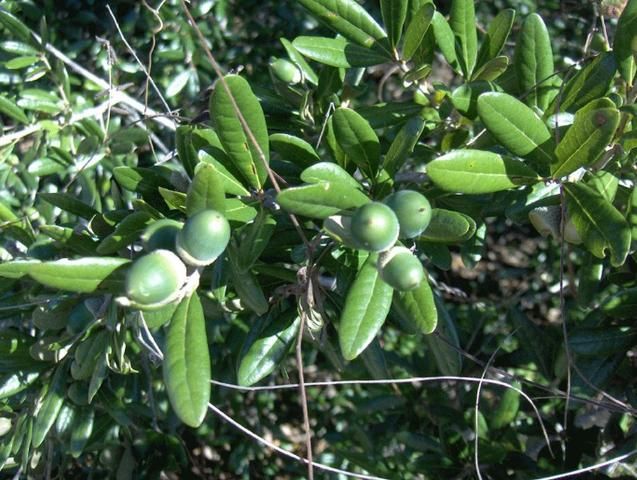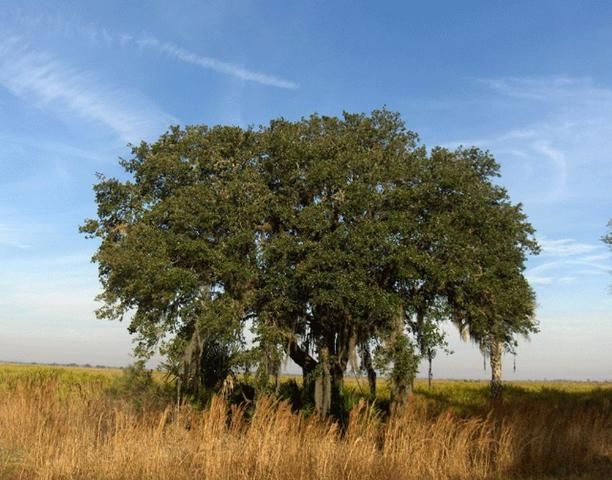Family
Fagaceae, beech and oak family.
Genus
Quercus comes from the Latin name for "oak" and is formed from two Celtic words: quer meaning "beautiful" and cuez meaning "tree."
Species
The species name geminata stems from the Latin term gemin, meaning "united in pairs, twins, double," and probably refers to the fact that acorns often occur in pairs.
Common Name
Sand Live Oak
This species is commonly known as sand live oak because it exhibits many morphological characteristics similar to those of the live oak (Quercus virginiana). However, it grows in sandy, scrub habitat and does not reach the towering dimensions of the live oak.
Description
This small, native, evergreen tree is found along the coastal plain of Louisiana east to North Carolina and south throughout most of peninsular Florida. It can be found in the xeric sandy soils of coastal dunes, hardwood forests, mixed pine uplands, scrub, and sandhills. Sand live oak grows best in partial shade to full sun and generally reaches heights of 50 feet, but has been documented as reaching heights as tall as 95 feet. The thick, leathery leaves are simple and alternate and range from 1½ to 2½ inches long. They are elliptical in shape with coarse veins that are deeply pressed into the leaf surface, and they have smooth margins that are, in many cases, highly revolute or inwardly curling. The upper surface of the leaf is dark green and the underside is a dull gray to almost whitish color with sparse to copious pubescence or hairs. The presence of this leaf pubescence, along with the upper surface venation, can aid in distinguishing sand live oak from live oak. The twigs also will have some pubescence when they are immature. The bark is rough to the touch, dark brown, and deeply furrowed. Acorns range from 5/8 to 1 inch long with 1/3 of the dark brown, egg-shaped nut enclosed in a scaly, whitish gray cup. Acorns are produced annually and appear in groups of 1 to 3 in the fall.

Credit: Homer Edward Price, CC BY 2.0

Credit: Homer Edward Price, CC BY 2.0
Allergen
All members of this genus are known to produce large amounts of pollen, making both deciduous and evergreen oaks highly to extremely allergenic.
Storm Tolerance
Sand live oak is highly resistant to wind.
Applications
Horticultural
Though it is a smaller-statured tree, sand live oak may be used for landscaping in the same way that live oak is used. A fact to keep in mind when selecting sand live oak at a nursery is that some forms are shrubbier and less treelike than others. Before making a purchase, ask the nursery staff whether mature specimens are available to view the growth form. This will ensure that trees purchased will meet any sought-after requirements. Homeowners and others should be aware that the leaves and acorns of this tree are high in tannin, which can stain concrete.
Wildlife
The sand live oak's annual production of acorns provides many species of wildlife with a food source.
References
Austin, D. F. 2004. Florida ethnobotany. Boca Raton, FL: CRC Press.
Borror, D. J. 1988. Dictionary of root words and combining forms (1st ed.). Mountain View, CA: Mayfield Publishing Company.
Duryea, M. and E. Kampf. 2007. Selecting southeastern Coastal Plain tree species for wind resistance (FOR119). Gainesville, FL: UF/IFAS Extension. Retrieved from https://edis.ifas.ufl.edu/fr174.
Gledhill, D. 1989. The names of plants (2nd ed.). Cambridge: Press Syndicate of the University of Cambridge.
Godfrey, R. K. 1988. Trees, shrubs, and woody vines of Northern Florida and adjacent Georgia and Alabama. Athens, GA: The University of Georgia Press.
Nelson, G. 1994. The trees of Florida: A reference and field guide. Sarasota, FL: Pineapple Press.
Ogren, T. L. 2000. Allergy-free gardening: The revolutionary guide to healthy landscaping. Berkeley, CA: Ten Speed Press.
Osorio, R. 2001. A gardener's guide to Florida's native plants. Gainesville, FL: University Press of Florida.
Stein, J., D. Binion, and R. Acciavatti. 2003. Field guide to native oak species of Eastern North America. Morgantown, WV: USDA Forest Service.